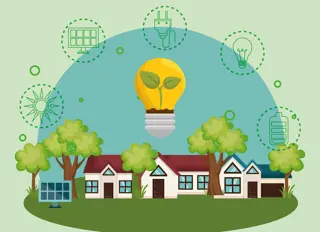Ahmedabad's Green Revolution: Smart Housing Aligns with 2025 Sustainability Goals
 Introduction: The Push for Sustainable Living
As Ahmedabad gears up for a massive population surge expected to hit 12.43 million by 2050 the city faces two big challenges: meeting housing demand while cutting down carbon emissions significantly. This is pushing a wave of smart, eco-friendly housing developments that blend renewable energy systems and green building materials. By 2025, Ahmedabad’s residential sector is set to become a national model for sustainable urban living, focusing on energy efficiency, reduced resource use, and climate-resilient design.
Introduction: The Push for Sustainable Living
As Ahmedabad gears up for a massive population surge expected to hit 12.43 million by 2050 the city faces two big challenges: meeting housing demand while cutting down carbon emissions significantly. This is pushing a wave of smart, eco-friendly housing developments that blend renewable energy systems and green building materials. By 2025, Ahmedabad’s residential sector is set to become a national model for sustainable urban living, focusing on energy efficiency, reduced resource use, and climate-resilient design.
Key Eco-Friendly Housing Developments Developers are focusing on carbon-neutral construction through:
- Solar-Powered Homes: Projects like Goyal Co’s Sanand feature solar rooftops and grids for energy independence.
- High-Efficiency Buildings: These use double-glazed windows, smart HVAC systems, and recycled materials to cut down on energy use.
- Integrated Green Spaces: New projects develop with large parks, vertical gardens, and rainwater harvesting systems.
Green Building Certifications Casting Market Appeal Demonstrated commitment to sustainability boosts property value and buyer interest:
LEED (Leadership in Energy and Environmental Design)
- Sets strict energy, water, and material efficiency standards
- Popular in upscale residential complexes in Vaishnodevi Circle and Ambli
IGBC (Indian Green Building Council)
- Emphasizes using local resources, like regional plants for landscaping
- Seen in projects near Sindhu Bhavan Road with low-carbon concrete mixes
GRIHA (Green Rating for Integrated Habitat Assessment)
- Focuses on solar panel integration design for thermal comfort
- Adopted by mid-income housing schemes aiming for emission reductions
Market Trends and Consumer Sentiment
| Aspect | 2025 Trend | Consumer Perception |
|---|---|---|
| Pricing | 5-15% premium over conventional homes | Seen as a long-term investment with lower utility bills |
| Demographic Focus | Middle-class buyers for flats in affordable housing projects | Strong preference for eco-certified buildings with smart features |
| Location Preference | Growth in Sanand and peri-urban areas | Urban centers see increased demand for energy-efficient studios |
| Technology Adoption | IoT-enabled energy management systems | High trust in smart home automations safeguarding water/energy |
Challenges and Strategic Solutions Addressing environmental impacts while scaling construction:
- Material Demand Scaling: By 2050, Ahmedabad might need 3.1 million new housing units, driven by unregulated cement/steel usage. Solutions include prefabricated construction and sourcing local materials.
- CO₂ Emission Surge: Building construction could account for over 50% of urban emissions. Developers are exploring low-carbon alternatives like bamboo composite boards and polymer-modified cement.
- Policy Gaps: Pushing for stricter waste management and circular economy practices in construction to align with India’s net-zero targets.
Conclusion: Sustainable Housing as Economic Catalyst Ahmedabad’s 2025 real estate landscape of smart technologies, green certifications, and affordable housing models positions it as a climate leader. Early adopters whether developers or homebuyers are setting themselves up for long-term gains in a market increasingly valuing ecological stewardship and resource efficiency.